The Stans, and the Buddhas Sweet Tooth.
Continuing at the AFC Challenge Cup, the first game in Group B saw India play Kyrgyzstan. On a hot but dry afternoon, the game started in front of barely 100 people. It was no surprise that the game started at a slow pace, but Kyrgyzstan soon gained some semblance of control. India have entered their Under-23 team in this tournament, having won the SAFF competition with the same squad, (for the South Asian Games, an U-23 tournament, they played their U-19 team). Because of this, this game is not registered with FIFA as a full international. It appears the young team was not good enough against a Central Asian side who believe in their ability to do well here. On 15 minutes a cross by Kuleutin was parried out by Karanjit leaving Amirov with an open goal. The score was doubled on 32 minutes when Zemlanuhin capitalised on a mistake by Rowilson and finished with aplomb. India could have pulled a goal back a minute later when Abranches shot hit the post, but this was India’s best chance of the half, while first Zemlianuhin, with a glancing header that went just wide and then Amirov with a shot that Karanjit was forced to save could have increased the score.
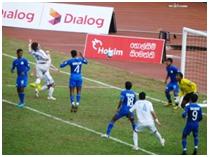
India on the defensive as Kuleutin heads wide
The second half was a completely different tale. Kyrgyzstan’s captain, Bokoev was sent off in the 47th minute for elbowing Baljit Sahni, while India stepped up the pace and gained control of the game. Kyrgyzstan now struggled in the heat and were forced to pull back and defend. Jewel Raja came close with two chances, the first blocked by Baimatov and the second blasted over. The pressure finally paid off when India were awarded a penalty for hand ball. India dominated the rest of the game, but struggled to make real chances from their possession while the Kyrgyzstan defence held strong. The best of their late chances came when Abranches blasted a shot over five minutes from the end.
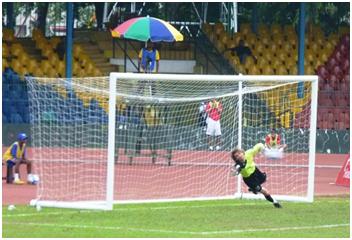
Volkov cannot reach Denzil’s penalty
The size of the crowd increased for the second game, but never reached the 800 claimed by the organisers for the first match. North Korea brought a very young side into this tournament but with places in the world cup squad supposedly up for grabs, they were guaranteed to be eager, and they started both halves of this game playing with pace, and chasing long balls sent over the Turkmenistan defence. Their best early chance was after just five minutes when Ryang Yong Gi was put through, but wasted the chance after a poor first touch. The heat however soon appeared to be too much for them, and they visibly wilted, allowing their opponents into the game. Turkmenistan have a much more experienced side, but still very few remain from when I saw the pair play in Pyongyang in 2008. They came into the game as the Koreans began to struggle and took the lead in the 36th minute through Mamedaly. The North Koreans tried an odd free kick routine with three players kneeling in front of the wall, and another two to the side of it, but it came to nothing as Pak Song Chol shot high over the bar. This turned out to be the last move of the half. Six minutes into the second period, the Koreans got another free kick, but this time went for a simple routine without disrupting the wall this time Ryang Yong Gi curled the ball just inside the far post to level the scores. Pak Chol Min missed a chance to put North Korea ahead five minutes later. As in the first half, the Koreans began to run out of steam allowing chances for Turkmenistan, with Amanov sending the ball just over the bar on the hour mark.
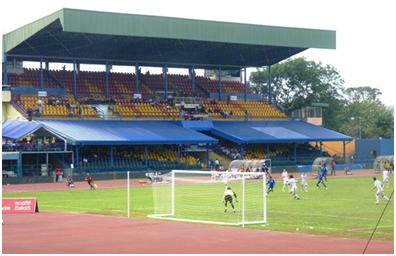
Sugathadasa Stadium Main Stand
Turkmenistan’s chances were ruined though in the 67th minute when an ill-timed challenge by Omar earned the player his second booking of the game. It means that all of the first four matches have seen a red card. Down to ten men, Turkmenistan resorted to time wasting to hold on to the result, while North Korea were eager to take advantage, but unable. Most of their chances ended with shots from long range and lacked accuracy. The North Korean coach said he was happy with the result, but cited the heat (clearly most team’s favourite excuse here). The Turkmenistan coach accepted the red card, saying “this is football”, but said the team were here to win and could improve for the next match.
The second day gave us a poor first viewing of the two teams who at full strength would be favourites. India beat Kyrgyzstan in the recent Nehru Cup on their own territory, but none of the Indian first team squad were retained here, while the Kyrgyzstan side involved many of the same players. Similarly, North Korea only used one player who was in the World Cup qualifying campaign, when a stronger squad could well give them the chance to move on to the Asian Cup. Against these two, both playing at substandard strength, we have two Central Asian ‘Stans’ who want to win the tournament. On Friday we will again see the two ‘Stans’ in separate games, and if they can keep eleven players on the pitch, then I feel they may well prove to have the strengths to qualify from this group.
On the Thursday we took a day off from the football and went to Kandy. The football itself did not take a day off, with another series of games in Group A. It shows the interest in the country that as far as we could see, not only was there no interest in the tournament from Sri Lanka’s second city, hardly anyone knew it was being played. The first news we could get from the event was at the bus terminal in the morning. As there were no English language newspapers available, I asked the vendor to look at the sports pages of one of the Sinhalese editions. This carried a report on Sri Lanka’s match, saying they lost 2-1 to Tajikistan. As it turned out, they had actually lost 3-1. Meanwhile Myanmar beat Bangladesh in the evening game, but this did not make the papers. To get to Kandy, we took the train, travelling on the so called “First class observation car”. This has more comfortable seats that second class, a fan that works some of the times, natural air-conditioning (or as we normally call it, an open window). Finally the rear windows are fully glassed, allowing us to observe where we had come from. As promised, there is a short section of the line where the train travels high above a valley, giving spectacular views, but much more of the journey was passing through built up areas. So what we got was a good view of the tin shacks that many Sri Lankans call home. Meanwhile, using the railway lines as a footpath we saw schoolchildren in pristine white uniforms. Amazingly, these children were disgorged from the untidy hovels we see.
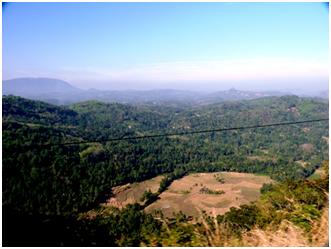
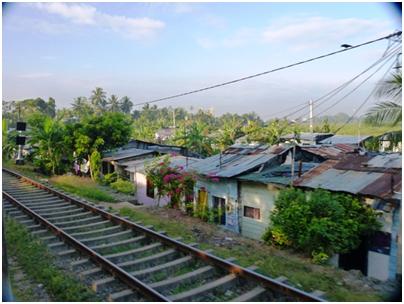
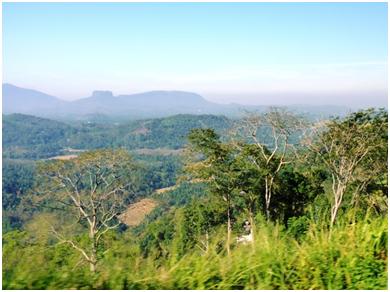
Kandy is a good place to spend a day or so away from the capital. It has a bustling centre, and as in Colombo it is difficult for someone with white skin to walk far before they get accosted by a local trying to sell them some type of goods or service. With hardly any of these being things that tourists might want, it gets wearing very quickly. Of course, anyone wanted to import coconuts carved into elephants may find a supplier here. A quick tourist can come up and down and see the main sight in a day the observation car train arrives around 09.30 and leaves for the return trip at 15.00. This is enough time to wander through the town, see the views from the lake, explore the Temple of the Buddha’s Tooth, and have lunch in the old and not quite majestic Queen’s Hotel. There are plenty of other sites in Kandy, but my list completes those that you would go to Kandy to see, as opposed to seeing because you are in Kandy. We did choose to spend the night, staying at the Palm Garden Guest House, a moderately priced establishment that is the wrong way from the station that is further away than readers of the “Lonely Planet” guide book may expect. It was exactly a “Lonely Planet” sort of guesthouse family run with extremely friendly and helpful staff, fans and mosquito nets, but no air conditioning, and slightly curious rooms. In my bathroom, it was a squeeze to get past the lavatory to the shower, and to be seated straight on the facility, one would need to be a midget with at least leg amputated. As I found out later, mosquito nets work both ways if a mosquito is inside, there is no way out.
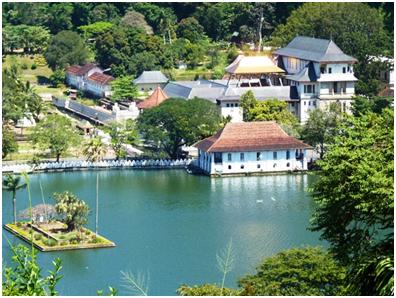
The Temple of Buddha’s tooth from a viewpoint. The Tooth itself is in the pavilion with the gold roof.
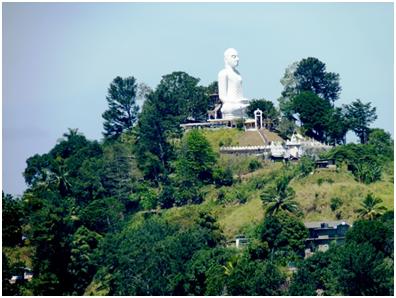
A Giant Buddha looks down on the city
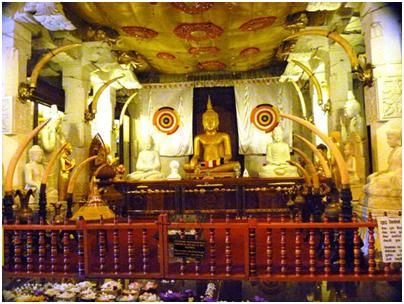
Inside the Temple of Buddha’s Tooth. Note, that you do not get to see the actual tooth.
As well as being well known for Cricket, Kandy has a quite passable football ground. Apparently also used for Athletics although the track is grassed. The outside is cunningly disguised as a bus depot, but I was not fooled. A second problem, on reaching the gate was a guard whose sole purpose appeared to be to stop tourists from taking photographs. He must have thought it was his busy day as after six months without a tourist to stop, both Kevin and I tried separately to gain access. Success had gone to the guard’s head though and he allowed me to take a picture, although moving more than ten yards from the gate was prohibited.
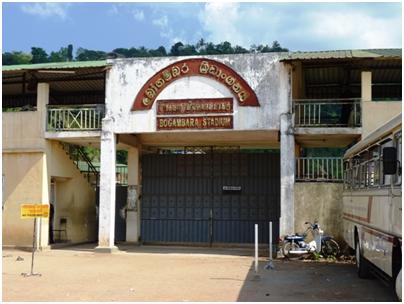
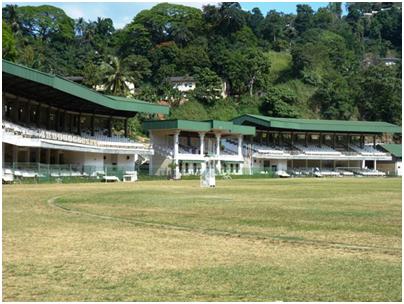
Despite the curved stands, the grounds are too small for cricket. I left, disappointed that I had not seen a game at these stylish grounds. We returned to Colombo by bus. Not the best idea, as being crammed into a stuffy can like so many sardines is not my idea of fun. It was an air conditioned bus, but this just means the windows don’t open. The driver had to be persuaded to turn the air con on, and even then it did little to cool the back of the bus. There was not much scenery en route, with towns every two to three kilometres down the road, and every town home to it’s own set of traffic lights and attached traffic jams.